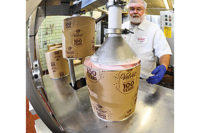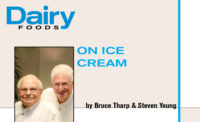The term “cryogenic” refers to the achievement of extremely low temperatures, generally considered to be in the range of < -285 F, using materials such as liquid nitrogen (LN).
The cryogenic freezing of ice cream is appealing because the very rapid temperature drop it produces generates extremely small ice crystals that promote smooth texture and extended textural shelf life. To date, technical, operational and economic factors have limited its use in conventional production to a few value-added products such as novelties and ice cream cakes/pies.
The first contemporary application of cryogenic freezing to ice cream involved the production of non-traditional “pelletized ice cream,” i.e., spherical pellets of frozen ice cream mix made by the introduction of droplets of liquid mix into LN, from which the frozen particles are recovered for packaging.
Originally, dry ice (CO2 at < -109 F) was used to achieve the very low distribution temperatures needed to maintain the individual identity of the particles of these products. Later, modifications were developed in which the freezing point was increased to freeze enough water at any given temperature to generate sufficient hardness to maintain particle identity during conventional ice cream distribution. The modifications involved reducing the level of water-soluble sweeteners enough to raise the freezing point to the necessary level, accompanied by the use of a high-intensity sweetener to maintain sweetness and, sometimes, a non-colligative bulking agent to maintain a desirable body and operational behavior.
Cryogenic freezing has been used at the dip shop level to produce individual servings of ice cream for immediate consumption by adding LN to ice cream mix while stirring in a small container. The mix freezes quickly into a ready-to-eat semi-solid with the smooth and creamy eating quality associated with high-quality ice cream. The consumer experience is enhanced by a spectacular outpouring of vapor during freezing that adds an element of drama to the process.
Inside-out freezing with cryobits
Most recently, a modified hardening process has been developed with the potential to add significantly to the quality and profitability of ice cream. It is referred to as “partial cryogenic hardening.” PCH involves a process in which a small amount of ice cream exiting a conventional continuous freezer is diverted from the primary flow and extruded into small portions (“cryobits”) which, after being cryogenically frozen in LN, are returned to the primary flow using a device such as a conventional particulate feeder.
The uniform distribution of the extremely cold cryobits supplies “inside-out” hardening that significantly accelerates temperature reduction of the packaged product. This shortens the residence time of the product in the higher hardening temperature range where the viscosity of the unfrozen portion of the ice cream is low enough to allow significant growth of ice crystals and air bubbles via ripening and disproportionation, respectively. Cryobits of the same product as the ice cream into which they are added become indistinguishable in the finished product.
A trial involving low-fat (5%) ice cream demonstrated the beneficial effects of PCH versus those of traditional hardening (TH) of half-gallon packages on the management of the size of ice crystals and air bubbles. In that trial during hardening, the PCH product reached 15 F in a half-hour, while TH product required ~8 hours. In heat-shocked product at 100% overrun, PCH ice crystals and air bubbles were significantly smaller than those in the TH product, reflecting a superior texture stability and creaminess in the PCH product.
Similar differences were seen in products frozen at 135% overrun. In fact, ice crystals and air bubbles in PCH products at 135% overrun were smaller than in TH products at 100%. Further, the melting profile and stiffness properties of the PCH ice cream at 135% overrun were quite similar to those of TH product at 100%. And, sensory evaluation showed that the PCH product at 135% overrun was equivalent to the TH product at 100%.
Thus, results of the trial suggest the potential for PCH to provide cost saving via its application to non-standardized products at higher overruns. As a corollary benefit, PCH offers marketing opportunities via using a product of contrasting flavor and/or color to produce the cryobits.
The effects of PCH observed in low-fat ice cream would likely be seen in full-fat ice cream and other frozen desserts. Thus, it is the most viable opportunity now visible for the beneficial application of cryogenic freezing in ice cream.
Learn more in Las Vegas
For more on cryogenic freezing and other freezing, whipping and hardening approaches, join Bruce Tharp and Steven Young at “Tharp & Young on Ice Cream: Technical Short Course, Workshops and Clinics”, Nov. 30 to Dec. 2 in Las Vegas. Read more about ice cream in “Tharp & Young on Ice Cream: An Encyclopedic Guide to Ice Cream Science and Technology” (2012; 400 pages). Go to www.onicecream.com or call 610-975-4424 or 281-782-4536




